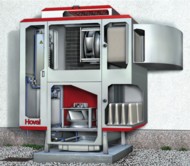Advancing the art of adiabatic cooling

Using adiabatic cooling to cool outside air which, in turn, cools inside air via a plate heat exchanger is the key to this approach of delivering comfort cooling with a COP of up to seven. It also enables adiabatic cooling to be integrated with techniques such as direct expansion.
A fresh approach to adiabatic cooling can provide an ideal solution where new or additional comfort cooling is required. Chris Ree explains how. As technologies move on and evolve in the light of experience they have the capacity to fulfil a wider range of roles than previously. Such is the case with indirect adiabatic cooling where a new development offers 20% increased cooling efficiencies compared to other methods, with a resulting coefficient of performance (COP) of up to seven. This high COP is achieved by a combination of indirect cooling and a patented pre-cooling design. Such units can be used to provide stand-alone cooling or they can easily be retrofitted to existing air-conditioning systems to boost installed cooling capacity very cost-effectively. A power input of just 3 kW can deliver up to 21 kW of cooling with an air flow of 6000 m3/h and the ability to add up to 20% fresh air to the supply air before cooling. Indirect adiabatic cooling has a very wide range of applications — including shopping centres, sports facilities, offices, factories and retail stores. In this process the outside air is humidified and then used to cool the supply air indirectly via a heat exchanger. As a result, there is no humidification or contamination of the supply air. At a time when building operators are looking to reduce their carbon footprint and broader environmental impact, this updated approach to indirect adiabatic cooling provides an ideal solution.
How it works Adiabatic cooling this refers to the humidification of air under adiabatic (isocaloric) conditions, so that energy is neither added nor removed. The heat necessary for evaporation is taken from the air, which consequently cools down. Adiabatic cooling can be indirect or direct. With direct adiabatic cooling, the air flow supplied to the space is humidified, increasing ambient humidity and also posing a risk of contamination of the supply air. Another approach is to implement indirect adiabatic cooling, where outside air is used to cool recirculating air which is extracted from the space and then returned, after cooling, as supply air. In this scenario, the outside air is humidified and then used to cool the recirculated air via a heat exchanger before being expelled back to the exterior.
With single-stage indirect adiabatic cooling, as described above, humidification and cooling occur at the same time and in the same place and can achieve an adiabatic efficiency of about 76%. As discussed below, this performance can be improved even further through the use of pre-cooling. The efficiency of the cooling process depends on both the quality of the humidification and the quality of the heat transfer, so it follows that any improvements to overall efficiency are addressed through these parameters. In the case of humidification, this will depend on the nature of the system used. Spray humidifiers are the most commonly used in Europe; these systems are reliable and sturdy and proven in many applications. Other suitable methods include contact humidifiers, popular in the USA, and cold-steam (ultrasonic) generators, which tend to have high running costs as they require demineralised water. In single-stage indirect adiabatic cooling, only plate heat exchangers are used. Two heat exchangers can be connected in series or, with smaller air flows, counter-current heat exchangers may be used.
Innovative approach Consideration of all of the variables has led to the innovative and patented concept of using a second heat exchanger as a pre-cooler for the cooling air. In Hoval’s AdiaVent, the air to be cooled is recirculated and returned to the conditioned space while outside air is effectively used as the refrigerant. Outside air is drawn through a filter and pre-cooled in a plate heat exchanger (the pre-cooler). This pre-cooled air then flows into a second cross-flow heat exchanger where it cools the recirculating supply air more efficiently than if it had not been pre-cooled. The outside air is then returned to the outside while condensed water returns to a reservoir to be recirculated (one feature of adiabatic cooling is that the temperature of the water does not influence the cooling effect). Such recirculated water is subjected to continuous anti-legionella measures such as disinfection using ultra-violet light. The water reservoir is emptied automatically at the end of each day of operation and the airflow is maintained through the plate heat exchangers to purging all moisture from the system. This use of pre-cooling makes it possible to reduce the cooling limit temperature and increase efficiency by around 20%, compared to coolers that do not use this patented approach. Where required, AdiaVent can be supplied with an integral direct-expansion coil and condensing unit to supplement the adiabatic cooling during times of peak cooling demand. Onboard automatic controls ensure that adiabatic cooling is used to its maximum potential so that energy performance is optimised.
Chris Ree is with Hoval.
Related links:




